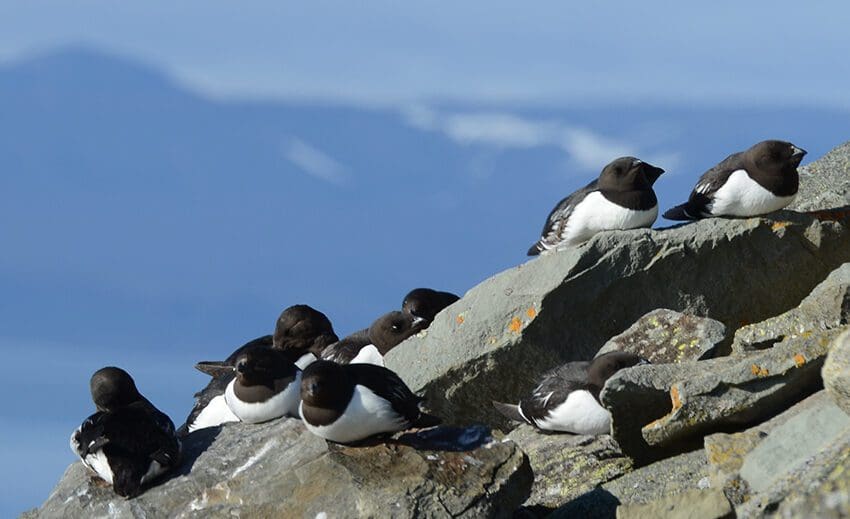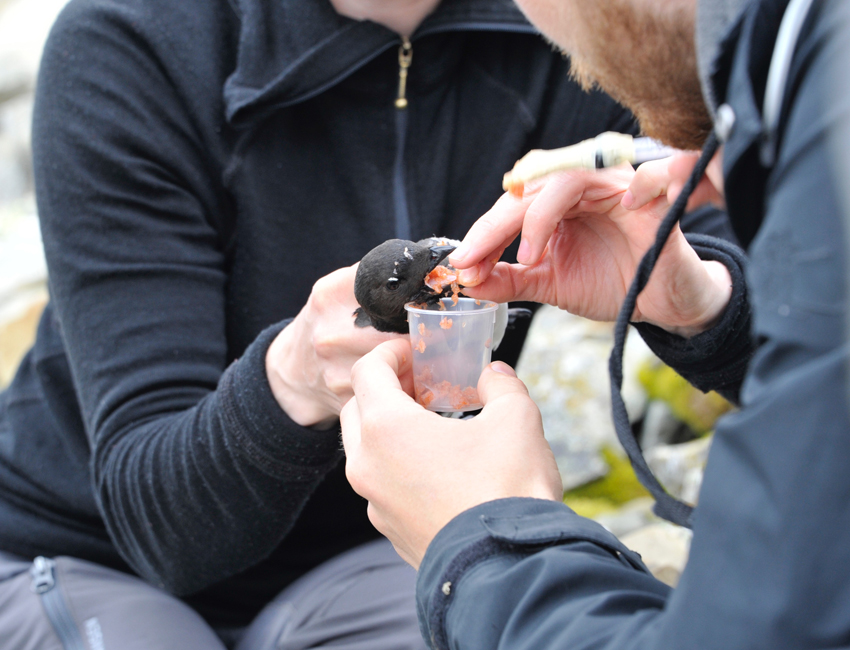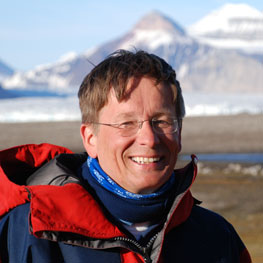AB-822 Fluxes of Nutrients, Energy and Contaminants from Sea to Land (10 ECTS)
ID:
AB-822
CREDITS:
10 ECTS
APPLICATION DEADLINE:
February 15, 2024
START DATE:
June 24, 2024
END DATE:
July 26, 2024

Little auks (Alle alle) photographed during AB-322 fieldwork. Photo: Geir Wing Gabrielsen/UNIS
| Grade: | Letter grade (A through F) |
| Course Cost: | None |
| Course Capacity Min/Max: | Min/Max: 10/20 students |
| Language of instruction: | English |
| Examination support material: | Bilingual dictionary between English and mother tongue |
Course requirements
Enrolment in a relevant PhD programme in biology. Basic knowledge in marine or terrestrial biology and chemistry will be advantageous.
Academic content
The students will gain insight into seabird ecology and fluxes of matter, nutrients, pollutants and energy from marine to terrestrial ecosystems. The course will focus on the connections across the terrestrial-marine boundary, and the importance of the marine environment and productivity for some Arctic terrestrial ecosystems.
The main topic of interest will be Arctic seabirds that nest in large, dense colonies, their dependence on the hydrological regime and biological productivity in the waters around Svalbard. The impact of seabirds on the terrestrial ecosystem will be studied. Bird guano has an important fertilizing effect on the vegetation in the vicinity of colonies. The lush green area below seabird colonies is an eye-catching feature of an otherwise impoverished Arctic landscape. These green oases are important grazing areas for herbivorous such as the Svalbard reindeer, Svalbard ptarmigan, geese and waders. These areas are also important hunting areas for carnivores such as the Arctic fox.
Students will also focus on the interdependence of terrestrial and marine environments for important groups of Arctic animals. The connection between land and sea will be described and quantified based on our current understanding of the topic. In order to get a first-hand experience, the students will have one week of intensive field work, analysis of samples in the laboratory and putting these data into a model to calculate the fluxes from sea to land, and from land (seabird colonies) to sea.
The AB-822 students will contribute and advise AB-322 students both during the field and in the laboratory work and when making the report from the study.
Learning outcomes
Upon completing the course, the students will:
Knowledge
- have a thorough understanding of all aspects of matter, nutrient, pollutants and energy fluxes from sea to land as well as the influence of seabird colonies on the marine ecosystem
- have a good theoretical/practical knowledge of seabird ecology and their contribution to terrestrial ecosystems
- be able to implement research based methods to study fluxes in Arctic ecosystems, and contribute to the development of new methods to study fluxes in marine and terrestrial ecosystems.
Skills
- be able to identify different seabird species and their food items, have knowledge on their ecology and their role in the Arctic ecosystem
- be able to conduct research based field work within marine- and terrestrial ecology, using relevant sampling techniques and methods to analyze collected data
- have skills to develop research questions/hypotheses for projects and be familiar with methods to be used when studying fluxes in ecosystems
- have knowledge of the ethics related to studies of wild animals.
General competences
- have practical experience from doing field sampling, putting field data into scientific contexts, conducting analyses of data, making interpretations of data, presenting the data/findings in context to the relevant literature
- have experience with making presentation for the scientific and public audience
- have experience with teaching and supervision of students
- have experience in writing a reports/publications from field and laboratory studies.
Learning activities:
The course extends over 5 weeks including compulsory safety training, and is run in combination with AB-322.
Prior to the course, the AB-822 students should make a presentation of their own doctoral work, and present this for the AB-322 students during the course.
Learning will be achieved via a combination of lectures, intensive field-, lab- and group work.
One week theoretical introduction and preparation of field activities will be followed by one week of field activities (work in the seabird colony and marine- and terrestrial excursions). Sampling will be conducted in the seabird colony (Bjørndalen) and in Isfjorden. A boat trip to other seabird colonies (Alkhornet) in Adventfjorden will be done during the field week of the course. The last part of the course will include lectures, laboratory analyses of samples, and work on a course report. Working in groups, the students will produce a scientific course report on the flux of matter and energy from the sea to the land, based on the course theory, field- and lab work. An oral presentation of the report sums up the course.
The AB-822 students will contribute and advise AB-322 students both during the field and in the laboratory work and when making the report from the study.
Summary
- Preparatory work to make a presentation of the doctoral work: 10 hours
- Total lecture hours: 30 hours
- Laboratory work: 25 hours
- Excursions/field work: 7 days
Compulsory learning activities:
All compulsory learning activities must be approved in order to sit the exam.
- Presentation of own doctoral work
- Field excursions and laboratory work, including advising the AB-322 students
- Oral presentation of the report
Assessment:
- All assessments must be passed in order to pass the course.
- Each assessment is graded, and subsequently combined into a single grade. Partial grades for each assessment will be available.
| Method | Length | Percentage of final grade |
|---|---|---|
| Written report | 50 % | |
| Written exam | 4 hours | 50 % |
Student life


